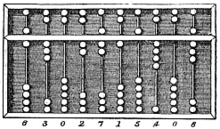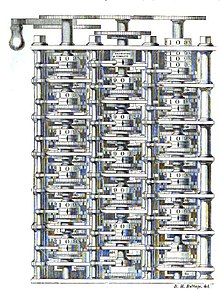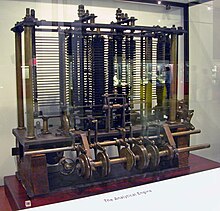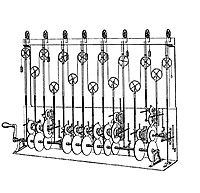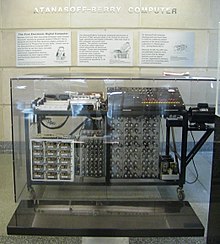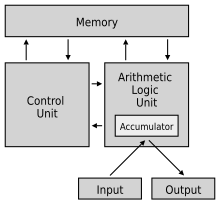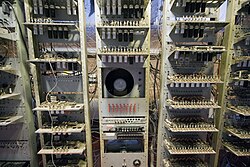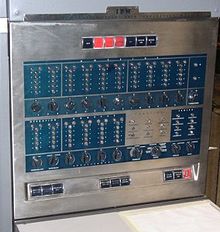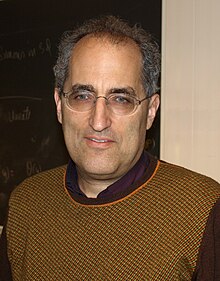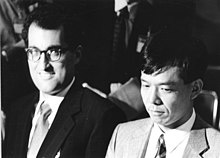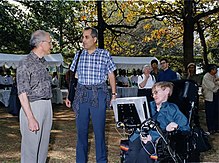Computing hardware is a platform for information processing.
Parts from four early computers, 1962. From left to right: ENIAC board,
EDVAC board, ORDVAC board, and BRLESC-I board, showing the trend toward
miniaturization.
The history of computing hardware covers the developments from early simple devices to aid calculation to modern day computers. Before the 20th century, most calculations were done by humans. Early mechanical tools to help humans with digital calculations, such as the abacus, were called "calculating machines", called by proprietary names, or referred to as calculators. The machine operator was called the computer.
The first aids to computation were purely mechanical devices which required the operator to set up the initial values of an elementary arithmetic operation, then manipulate the device to obtain the result. Later, computers represented numbers in a continuous form, for instance distance along a scale, rotation of a shaft, or a voltage. Numbers could also be represented in the form of digits, automatically manipulated by a mechanical mechanism. Although this approach generally required more complex mechanisms, it greatly increased the precision of results. A series of breakthroughs, such as miniaturized transistor computers, and the integrated circuit, caused digital computers to largely replace analog computers. The cost of computers gradually became so low that by the 1990s, personal computers, and then, in the 2000s, mobile computers, (smartphones and tablets) became ubiquitous in industrialized countries.
Early devices
Ancient era
The Ishango bone is thought to be a Paleolithic tally stick.[1]
Suanpan (the number represented on this abacus is 6,302,715,408)
Devices have been used to aid computation for thousands of years, mostly using one-to-one correspondence with fingers. The earliest counting device was probably a form of tally stick. Later record keeping aids throughout the Fertile Crescent included calculi (clay spheres, cones, etc.) which represented counts of items, probably livestock or grains, sealed in hollow unbaked clay containers.[2][3][4] The use of counting rods is one example. The abacus was early used for arithmetic tasks. What we now call the Roman abacus was used in Babylonia as early as c. 2700–2300 BC. Since then, many other forms of reckoning boards or tables have been invented. In a medieval European counting house, a checkered cloth would be placed on a table, and markers moved around on it according to certain rules, as an aid to calculating sums of money.
Several analog computers were constructed in ancient and medieval times to perform astronomical calculations. These included the south-pointing chariot (c. 1050–771 BC) from ancient China, and the astrolabe and Antikythera mechanism from the Hellenistic world (c. 150–100 BC).[5] In Roman Egypt, Hero of Alexandria (c. 10–70 AD) made mechanical devices including automata and a programmable cart.[6] Other early mechanical devices used to perform one or another type of calculations include the planisphere and other mechanical computing devices invented by Abu Rayhan al-Biruni (c. AD 1000); the equatorium and universal latitude-independent astrolabe by Abū Ishāq Ibrāhīm al-Zarqālī (c. AD 1015); the astronomical analog computers of other medieval Muslim astronomers and engineers; and the astronomical clock tower of Su Song (1094) during the Song dynasty. The castle clock, a hydropowered mechanical astronomical clock invented by Ismail al-Jazari in 1206, was the first programmable analog computer.[7][8][9] Ramon Llull invented the Lullian Circle: a notional machine for calculating answers to philosophical questions (in this case, to do with Christianity) via logical combinatorics. This idea was taken up by Leibniz centuries later, and is thus one of the founding elements in computing and information science.
Renaissance calculating tools
A set of John Napier's calculating tables from around 1680
Scottish mathematician and physicist John Napier discovered that the multiplication and division of numbers could be performed by the addition and subtraction, respectively, of the logarithms of those numbers. While producing the first logarithmic tables, Napier needed to perform many tedious multiplications. It was at this point that he designed his 'Napier's bones', an abacus-like device that greatly simplified calculations that involved multiplication and division.[10]
A slide rule
Since real numbers can be represented as distances or intervals on a line, the slide rule was invented in the 1620s, shortly after Napier's work, to allow multiplication and division operations to be carried out significantly faster than was previously possible.[11] Edmund Gunter built a calculating device with a single logarithmic scale at the University of Oxford. His device greatly simplified arithmetic calculations, including multiplication and division. William Oughtred greatly improved this in 1630 with his circular slide rule. He followed this up with the modern slide rule in 1632, essentially a combination of two Gunter rules, held together with the hands. Slide rules were used by generations of engineers and other mathematically involved professional workers, until the invention of the pocket calculator.[12]
Mechanical calculators
Wilhelm Schickard, a German polymath, designed a calculating machine in 1623 which combined a mechanised form of Napier's rods with the world's first mechanical adding machine built into the base. Because it made use of a single-tooth gear there were circumstances in which its carry mechanism would jam.[13] A fire destroyed at least one of the machines in 1624 and it is believed Schickard was too disheartened to build another.
View through the back of Pascal's calculator. Pascal invented his machine in 1642.
In 1642, while still a teenager, Blaise Pascal started some pioneering work on calculating machines and after three years of effort and 50 prototypes[14] he invented a mechanical calculator.[15][16] He built twenty of these machines (called Pascal's calculator or Pascaline) in the following ten years.[17] Nine Pascalines have survived, most of which are on display in European museums.[18] A continuing debate exists over whether Schickard or Pascal should be regarded as the "inventor of the mechanical calculator" and the range of issues to be considered is discussed elsewhere.[19]
Gottfried Wilhelm von Leibniz invented the stepped reckoner and his famous stepped drum mechanism around 1672. He attempted to create a machine that could be used not only for addition and subtraction but would utilise a moveable carriage to enable long multiplication and division. Leibniz once said "It is unworthy of excellent men to lose hours like slaves in the labour of calculation which could safely be relegated to anyone else if machines were used."[20] However, Leibniz did not incorporate a fully successful carry mechanism. Leibniz also described the binary numeral system,[21] a central ingredient of all modern computers. However, up to the 1940s, many subsequent designs (including Charles Babbage's machines of the 1822 and even ENIAC of 1945) were based on the decimal system.[22]
Around 1820, Charles Xavier Thomas de Colmar created what would over the rest of the century become the first successful, mass-produced mechanical calculator, the Thomas Arithmometer. It could be used to add and subtract, and with a moveable carriage the operator could also multiply, and divide by a process of long multiplication and long division.[23] It utilised a stepped drum similar in conception to that invented by Leibniz. Mechanical calculators remained in use until the 1970s.
Punched card data processing
In 1804, Joseph-Marie Jacquard developed a loom in which the pattern being woven was controlled by a paper tape constructed from punched cards. The paper tape could be changed without changing the mechanical design of the loom. This was a landmark achievement in programmability. His machine was an improvement over similar weaving looms. Punched cards were preceded by punch bands, as in the machine proposed by Basile Bouchon. These bands would inspire information recording for automatic pianos and more recently numerical control machine tools.
IBM punched card Accounting Machines, pictured in 1936
In the late 1880s, the American Herman Hollerith invented data storage on punched cards that could then be read by a machine.[24] To process these punched cards he invented the tabulator, and the keypunch machine. His machines used electromechanical relays and counters.[25] Hollerith's method was used in the 1890 United States Census. That census was processed two years faster than the prior census had been.[26] Hollerith's company eventually became the core of IBM.
By 1920, electromechanical tabulating machines could add, subtract and print accumulated totals.[27] Machine functions were directed by inserting dozens of wire jumpers into removable control panels. When the United States instituted Social Security in 1935, IBM punched card systems were used to process records of 26 million workers.[28] Punched cards became ubiquitous in industry and government for accounting and administration.
Leslie Comrie's articles on punched card methods and W.J. Eckert's publication of Punched Card Methods in Scientific Computation in 1940, described punched card techniques sufficiently advanced to solve some differential equations[29] or perform multiplication and division using floating point representations, all on punched cards and unit record machines. Such machines were used during World War II for cryptographic statistical processing, as well as a vast number of administrative uses. The Astronomical Computing Bureau, Columbia University, performed astronomical calculations representing the state of the art in computing.[30][31]
The book IBM and the Holocaust by Edwin Black outlines the ways in which IBM's technology helped facilitate Nazi genocide through generation and tabulation of punch cards based upon national census data. See also: Dehomag
Calculators
The Curta calculator could also do multiplication and division.
By the 20th century, earlier mechanical calculators, cash registers, accounting machines, and so on were redesigned to use electric motors, with gear position as the representation for the state of a variable. The word "computer" was a job title assigned to primarily women who used these calculators to perform mathematical calculations.[32] By the 1920s, British scientist Lewis Fry Richardson's interest in weather prediction led him to propose human computers and numerical analysis to model the weather; to this day, the most powerful computers on Earth are needed to adequately model its weather using the Navier–Stokes equations.[33]
Companies like Friden, Marchant Calculator and Monroe made desktop mechanical calculators from the 1930s that could add, subtract, multiply and divide.[34] In 1948, the Curta was introduced by Austrian inventor Curt Herzstark. It was a small, hand-cranked mechanical calculator and as such, a descendant of Gottfried Leibniz's Stepped Reckoner and Thomas's Arithmometer.
The world's first all-electronic desktop calculator was the British Bell Punch ANITA, released in 1961.[35][36] It used vacuum tubes, cold-cathode tubes and Dekatrons in its circuits, with 12 cold-cathode "Nixie" tubes for its display. The ANITA sold well since it was the only electronic desktop calculator available, and was silent and quick. The tube technology was superseded in June 1963 by the U.S. manufactured Friden EC-130, which had an all-transistor design, a stack of four 13-digit numbers displayed on a 5-inch (13 cm) CRT, and introduced reverse Polish notation (RPN).
First general-purpose computing device
A portion of Babbage's Difference engine
Charles Babbage, an English mechanical engineer and polymath, originated the concept of a programmable computer. Considered the "father of the computer",[37] he conceptualized and invented the first mechanical computer in the early 19th century. After working on his revolutionary difference engine, designed to aid in navigational calculations, in 1833 he realized that a much more general design, an Analytical Engine, was possible. The input of programs and data was to be provided to the machine via punched cards, a method being used at the time to direct mechanical looms such as the Jacquard loom. For output, the machine would have a printer, a curve plotter and a bell. The machine would also be able to punch numbers onto cards to be read in later. It employed ordinary base-10 fixed-point arithmetic.
The Engine incorporated an arithmetic logic unit, control flow in the form of conditional branching and loops, and integrated memory, making it the first design for a general-purpose computer that could be described in modern terms as Turing-complete.[38][39]
There was to be a store, or memory, capable of holding 1,000 numbers of 40 decimal digits each (ca. 16.7 kB). An arithmetical unit, called the "mill", would be able to perform all four arithmetic operations, plus comparisons and optionally square roots. Initially it was conceived as a difference engine curved back upon itself, in a generally circular layout,[40] with the long store exiting off to one side. (Later drawings depict a regularized grid layout.)[41] Like the central processing unit (CPU) in a modern computer, the mill would rely upon its own internal procedures, roughly equivalent to microcode in modern CPUs, to be stored in the form of pegs inserted into rotating drums called "barrels", to carry out some of the more complex instructions the user's program might specify.[42]
Reconstruction of Babbage's Analytical Engine, the first general-purpose programmable computer
The programming language to be employed by users was akin to modern day assembly languages. Loops and conditional branching were possible, and so the language as conceived would have been Turing-complete as later defined by Alan Turing. Three different types of punch cards were used: one for arithmetical operations, one for numerical constants, and one for load and store operations, transferring numbers from the store to the arithmetical unit or back. There were three separate readers for the three types of cards.
The machine was about a century ahead of its time. However, the project was slowed by various problems including disputes with the chief machinist building parts for it. All the parts for his machine had to be made by hand—this was a major problem for a machine with thousands of parts. Eventually, the project was dissolved with the decision of the British Government to cease funding. Babbage's failure to complete the analytical engine can be chiefly attributed to difficulties not only of politics and financing, but also to his desire to develop an increasingly sophisticated computer and to move ahead faster than anyone else could follow. Ada Lovelace, Lord Byron's daughter, translated and added notes to the "Sketch of the Analytical Engine" by Luigi Federico Menabrea. This appears to be the first published description of programming, so Ada Lovelace is widely regarded as the first computer programmer.[43]
Following Babbage, although unaware of his earlier work, was Percy Ludgate, an accountant from Dublin, Ireland. He independently designed a programmable mechanical computer, which he described in a work that was published in 1909.[44]
Analog computers
Sir William Thomson's third tide-predicting machine design, 1879–81
In the first half of the 20th century, analog computers were considered by many to be the future of computing. These devices used the continuously changeable aspects of physical phenomena such as electrical, mechanical, or hydraulic quantities to model the problem being solved, in contrast to digital computers that represented varying quantities symbolically, as their numerical values change. As an analog computer does not use discrete values, but rather continuous values, processes cannot be reliably repeated with exact equivalence, as they can with Turing machines.[45]
The first modern analog computer was a tide-predicting machine, invented by Sir William Thomson, later Lord Kelvin, in 1872. It used a system of pulleys and wires to automatically calculate predicted tide levels for a set period at a particular location and was of great utility to navigation in shallow waters. His device was the foundation for further developments in analog computing.[46]
The differential analyser, a mechanical analog computer designed to solve differential equations by integration using wheel-and-disc mechanisms, was conceptualized in 1876 by James Thomson, the brother of the more famous Lord Kelvin. He explored the possible construction of such calculators, but was stymied by the limited output torque of the ball-and-disk integrators.[47] In a differential analyzer, the output of one integrator drove the input of the next integrator, or a graphing output.
A Mk. I Drift Sight. The lever just in front of the bomb aimer's
fingertips sets the altitude, the wheels near his knuckles set the wind
and airspeed.
An important advance in analog computing was the development of the first fire-control systems for long range ship gunlaying. When gunnery ranges increased dramatically in the late 19th century it was no longer a simple matter of calculating the proper aim point, given the flight times of the shells. Various spotters on board the ship would relay distance measures and observations to a central plotting station. There the fire direction teams fed in the location, speed and direction of the ship and its target, as well as various adjustments for Coriolis effect, weather effects on the air, and other adjustments; the computer would then output a firing solution, which would be fed to the turrets for laying. In 1912, British engineer Arthur Pollen developed the first electrically powered mechanical analogue computer (called at the time the Argo Clock).[citation needed] It was used by the Imperial Russian Navy in World War I.[citation needed] The alternative Dreyer Table fire control system was fitted to British capital ships by mid-1916.
Mechanical devices were also used to aid the accuracy of aerial bombing. Drift Sight was the first such aid, developed by Harry Wimperis in 1916 for the Royal Naval Air Service; it measured the wind speed from the air, and used that measurement to calculate the wind's effects on the trajectory of the bombs. The system was later improved with the Course Setting Bomb Sight, and reached a climax with World War II bomb sights, Mark XIV bomb sight (RAF Bomber Command) and the Norden[48] (United States Army Air Forces).
The art of mechanical analog computing reached its zenith with the differential analyzer,[49] built by H. L. Hazen and Vannevar Bush at MIT starting in 1927, which built on the mechanical integrators of James Thomson and the torque amplifiers invented by H. W. Nieman. A dozen of these devices were built before their obsolescence became obvious; the most powerful was constructed at the University of Pennsylvania's Moore School of Electrical Engineering, where the ENIAC was built.
A fully electronic analog computer was built by Helmut Hölzer in 1942 at Peenemünde Army Research Center .[50][51][52]
By the 1950s the success of digital electronic computers had spelled the end for most analog computing machines, but hybrid analog computers, controlled by digital electronics, remained in substantial use into the 1950s and 1960s, and later in some specialized applications.
Advent of the digital computer
The principle of the modern computer was first described by computer scientist Alan Turing, who set out the idea in his seminal 1936 paper,[53] On Computable Numbers. Turing reformulated Kurt Gödel's 1931 results on the limits of proof and computation, replacing Gödel's universal arithmetic-based formal language with the formal and simple hypothetical devices that became known as Turing machines. He proved that some such machine would be capable of performing any conceivable mathematical computation if it were representable as an algorithm. He went on to prove that there was no solution to the Entscheidungsproblem by first showing that the halting problem for Turing machines is undecidable: in general, it is not possible to decide algorithmically whether a given Turing machine will ever halt.He also introduced the notion of a 'Universal Machine' (now known as a Universal Turing machine), with the idea that such a machine could perform the tasks of any other machine, or in other words, it is provably capable of computing anything that is computable by executing a program stored on tape, allowing the machine to be programmable. Von Neumann acknowledged that the central concept of the modern computer was due to this paper.[54] Turing machines are to this day a central object of study in theory of computation. Except for the limitations imposed by their finite memory stores, modern computers are said to be Turing-complete, which is to say, they have algorithm execution capability equivalent to a universal Turing machine.
Electromechanical computers
The era of modern computing began with a flurry of development before and during World War II. Most digital computers built in this period were electromechanical – electric switches drove mechanical relays to perform the calculation. These devices had a low operating speed and were eventually superseded by much faster all-electric computers, originally using vacuum tubes.The Z2 was one of the earliest examples of an electromechanical relay computer, and was created by German engineer Konrad Zuse in 1940. It was an improvement on his earlier Z1; although it used the same mechanical memory, it replaced the arithmetic and control logic with electrical relay circuits.[55]
In the same year, electro-mechanical devices called bombes were built by British cryptologists to help decipher German Enigma-machine-encrypted secret messages during World War II. The bombes' initial design was created in 1939 at the UK Government Code and Cypher School (GC&CS) at Bletchley Park by Alan Turing,[56] with an important refinement devised in 1940 by Gordon Welchman.[57] The engineering design and construction was the work of Harold Keen of the British Tabulating Machine Company. It was a substantial development from a device that had been designed in 1938 by Polish Cipher Bureau cryptologist Marian Rejewski, and known as the "cryptologic bomb" (Polish: "bomba kryptologiczna").
In 1941, Zuse followed his earlier machine up with the Z3,[58] the world's first working electromechanical programmable, fully automatic digital computer.[59] The Z3 was built with 2000 relays, implementing a 22 bit word length that operated at a clock frequency of about 5–10 Hz.[60] Program code and data were stored on punched film. It was quite similar to modern machines in some respects, pioneering numerous advances such as floating point numbers. Replacement of the hard-to-implement decimal system (used in Charles Babbage's earlier design) by the simpler binary system meant that Zuse's machines were easier to build and potentially more reliable, given the technologies available at that time.[61] The Z3 was probably a complete Turing machine. In two 1936 patent applications, Zuse also anticipated that machine instructions could be stored in the same storage used for data—the key insight of what became known as the von Neumann architecture, first implemented in the British SSEM of 1948.[62]
Zuse suffered setbacks during World War II when some of his machines were destroyed in the course of Allied bombing campaigns. Apparently his work remained largely unknown to engineers in the UK and US until much later, although at least IBM was aware of it as it financed his post-war startup company in 1946 in return for an option on Zuse's patents.
In 1944, the Harvard Mark I was constructed at IBM's Endicott laboratories;[63] it was a similar general purpose electro-mechanical computer to the Z3, but was not quite Turing-complete.
Digital computation
The term digital is suggested by George Stibitz and refers to all applications based on signals with two states – low (0) and high (1). That is why the decimal and binary computing are two ways to implement digital computing. A mathematical basis of digital computing is Boolean algebra, developed by the British mathematician George Boole in his work The Laws of Thought, published in 1854. His Boolean algebra was further refined in the 1860s by William Jevons and Charles Sanders Peirce, and was first presented systematically by Ernst Schröder and A. N. Whitehead.[64] In 1879 Gottlob Frege develops the formal approach to logic and proposes the first logic language for logical equations.[65]In the 1930s and working independently, American electronic engineer Claude Shannon and Soviet logician Victor Shestakov[66] both showed a one-to-one correspondence between the concepts of Boolean logic and certain electrical circuits, now called logic gates, which are now ubiquitous in digital computers.[67] They showed[68] that electronic relays and switches can realize the expressions of Boolean algebra. This thesis essentially founded practical digital circuit design.
Electronic data processing
Atanasoff–Berry Computer replica at first floor of Durham Center, Iowa State University
Purely electronic circuit elements soon replaced their mechanical and electromechanical equivalents, at the same time that digital calculation replaced analog. Machines such as the first IBM electronic accounting machine (US 2,580,740), the NCR electronic calculating machine (US 2,595,045), the Z3, the Atanasoff–Berry Computer, the Colossus computers, and the ENIAC were built by hand, using circuits containing relays or valves (vacuum tubes), and often used punched cards or punched paper tape for input and as the main (non-volatile) storage medium.[69]
The engineer Tommy Flowers joined the telecommunications branch of the General Post Office in 1926. While working at the research station in Dollis Hill in the 1930s, he began to explore the possible use of electronics for the telephone exchange. Experimental equipment that he built in 1934 went into operation 5 years later, converting a portion of the telephone exchange network into an electronic data processing system, using thousands of vacuum tubes.[46]
In the US, in the period summer 1937 to the fall of 1939 Arthur Dickinson (IBM) invented the first digital electronic computer.[70] This calculating device was fully electronic – control, calculations and output (the first electronic display).[71] John Vincent Atanasoff and Clifford E. Berry of Iowa State University developed the Atanasoff–Berry Computer (ABC) in 1942,[72] the first binary electronic digital calculating device.[73] This design was semi-electronic (electro-mechanical control and electronic calculations), and used about 300 vacuum tubes, with capacitors fixed in a mechanically rotating drum for memory. However, its paper card writer/reader was unreliable and the regenerative drum contact system was mechanical. The machine's special-purpose nature and lack of changeable, stored program distinguish it from modern computers.[74] The tests of the ABC computer in June 1942 were not successful. Instead of solving system of equations with 29 unknowns, the computer could solve system of equations with no more than three to five unknowns. The ABC computer was not completed and was abandoned.[75] In 1942 – 1943 Joseph Desch from NCR developed with the help from Allan Turing the first mass-produced electronic computer N530 for breaking the four-wheel Enigma. From August 1943 to the end of the WWII 180 machines were manufactured, and one third of them were sent to Bletchley Park, UK.[76]
The electronic programmable computer
Colossus was the first electronic digital programmable
computing device, and was used to break German ciphers during World War
II. It remained unknown, as a military secret, well into the 1970s
During World War II, the British at Bletchley Park (40 miles north of London) achieved a number of successes at breaking encrypted German military communications. The German encryption machine, Enigma, was first attacked with the help of the electro-mechanical bombes.[77] They ruled out possible Enigma settings by performing chains of logical deductions implemented electrically. Most possibilities led to a contradiction, and the few remaining could be tested by hand.
The Germans also developed a series of teleprinter encryption systems, quite different from Enigma. The Lorenz SZ 40/42 machine was used for high-level Army communications, termed "Tunny" by the British. The first intercepts of Lorenz messages began in 1941. As part of an attack on Tunny, Max Newman and his colleagues helped specify the Colossus.[78]
Tommy Flowers, still a senior engineer at the Post Office Research Station[79] was recommended to Max Newman by Alan Turing[80] and spent eleven months from early February 1943 designing and building the first Colossus.[81][82] After a functional test in December 1943, Colossus was shipped to Bletchley Park, where it was delivered on 18 January 1944[83] and attacked its first message on 5 February.[74]
Colossus rebuild seen from the rear of the device.
Colossus was the world's first electronic digital programmable computer.[46] It used a large number of valves (vacuum tubes). It had paper-tape input and was capable of being configured to perform a variety of boolean logical operations on its data, but it was not Turing-complete. Nine Mk II Colossi were built (The Mk I was converted to a Mk II making ten machines in total). Colossus Mark I contained 1500 thermionic valves (tubes), but Mark II with 2400 valves, was both 5 times faster and simpler to operate than Mark 1, greatly speeding the decoding process. Mark 2 was designed while Mark 1 was being constructed. Allen Coombs took over leadership of the Colossus Mark 2 project when Tommy Flowers moved on to other projects.[84]
Colossus was able to process 5,000 characters per second with the paper tape moving at 40 ft/s (12.2 m/s; 27.3 mph). Sometimes, two or more Colossus computers tried different possibilities simultaneously in what now is called parallel computing, speeding the decoding process by perhaps as much as double the rate of comparison.
Colossus included the first ever use of shift registers and systolic arrays, enabling five simultaneous tests, each involving up to 100 Boolean calculations, on each of the five channels on the punched tape (although in normal operation only one or two channels were examined in any run). Initially Colossus was only used to determine the initial wheel positions used for a particular message (termed wheel setting). The Mark 2 included mechanisms intended to help determine pin patterns (wheel breaking). Both models were programmable using switches and plug panels in a way their predecessors had not been.
ENIAC was the first Turing-complete electronic device, and performed ballistics trajectory calculations for the United States Army.[85]
ithout the use of these machines, the Allies would have been deprived of the very valuable intelligence that was obtained from reading the vast quantity of encrypted high-level telegraphic messages between the German High Command (OKW) and their army commands throughout occupied Europe. Details of their existence, design, and use were kept secret well into the 1970s. Winston Churchill personally issued an order for their destruction into pieces no larger than a man's hand, to keep secret that the British were capable of cracking Lorenz SZ cyphers (from German rotor stream cipher machines) during the oncoming Cold War. Two of the machines were transferred to the newly formed GCHQ and the others were destroyed. As a result, the machines were not included in many histories of computing.[86] A reconstructed working copy of one of the Colossus machines is now on display at Bletchley Park.
The US-built ENIAC (Electronic Numerical Integrator and Computer) was the first electronic programmable computer built in the US. Although the ENIAC was similar to the Colossus it was much faster and more flexible. It was unambiguously a Turing-complete device and could compute any problem that would fit into its memory. Like the Colossus, a "program" on the ENIAC was defined by the states of its patch cables and switches, a far cry from the stored program electronic machines that came later. Once a program was written, it had to be mechanically set into the machine with manual resetting of plugs and switches.
It combined the high speed of electronics with the ability to be programmed for many complex problems. It could add or subtract 5000 times a second, a thousand times faster than any other machine. It also had modules to multiply, divide, and square root. High-speed memory was limited to 20 words (about 80 bytes). Built under the direction of John Mauchly and J. Presper Eckert at the University of Pennsylvania, ENIAC's development and construction lasted from 1943 to full operation at the end of 1945. The machine was huge, weighing 30 tons, using 200 kilowatts of electric power and contained over 18,000 vacuum tubes, 1,500 relays, and hundreds of thousands of resistors, capacitors, and inductors.[87] One of its major engineering feats was to minimize the effects of tube burnout, which was a common problem in machine reliability at that time. The machine was in almost constant use for the next ten years.
Stored-program computer
Early computing machines had fixed programs. For example, a desk calculator is a fixed program computer. It can do basic mathematics, but it cannot be used as a word processor or a gaming console. Changing the program of a fixed-program machine requires re-wiring, re-structuring, or re-designing the machine. The earliest computers were not so much "programmed" as they were "designed". "Reprogramming", when it was possible at all, was a laborious process, starting with flowcharts and paper notes, followed by detailed engineering designs, and then the often-arduous process of physically re-wiring and re-building the machine.[88] With the proposal of the stored-program computer this changed. A stored-program computer includes by design an instruction set and can store in memory a set of instructions (a program) that details the computation.Theory
Design of the von Neumann architecture, 1947
The theoretical basis for the stored-program computer had been composed by Alan Turing in his 1936 paper. In 1945 Turing joined the National Physical Laboratory and began his work on developing an electronic stored-program digital computer. His 1945 report ‘Proposed Electronic Calculator’ was the first specification for such a device.
Meanwhile, John von Neumann at the Moore School of Electrical Engineering, University of Pennsylvania, circulated his First Draft of a Report on the EDVAC in 1945. Although substantially similar to Turing's design and containing comparatively little engineering detail, the computer architecture it outlined became known as the "von Neumann architecture". Turing presented a more detailed paper to the National Physical Laboratory (NPL) Executive Committee in 1946, giving the first reasonably complete design of a stored-program computer, a device he called the Automatic Computing Engine (ACE). However, the better-known EDVAC design of John von Neumann, who knew of Turing's theoretical work, received more publicity, despite its incomplete nature and questionable lack of attribution of the sources of some of the ideas.[46]
Turing thought that the speed and the size of computer memory were crucial elements, so he proposed a high-speed memory of what would today be called 25 KB, accessed at a speed of 1 MHz. The ACE implemented subroutine calls, whereas the EDVAC did not, and the ACE also used Abbreviated Computer Instructions, an early form of programming language.
Manchester "Baby"
A section of the Manchester Small-Scale Experimental Machine, the first stored-program computer
The Manchester Small-Scale Experimental Machine, nicknamed Baby, was the world's first stored-program computer. It was built at the Victoria University of Manchester by Frederic C. Williams, Tom Kilburn and Geoff Tootill, and ran its first program on 21 June 1948.[89]
The machine was not intended to be a practical computer but was instead designed as a testbed for the Williams tube, the first random-access digital storage device.[90] Invented by Freddie Williams and Tom Kilburn[91][92] at the University of Manchester in 1946 and 1947, it was a cathode ray tube that used an effect called secondary emission to temporarily store electronic binary data, and was used successfully in several early computers.
Although the computer was considered "small and primitive" by the standards of its time, it was the first working machine to contain all of the elements essential to a modern electronic computer.[93] As soon as the SSEM had demonstrated the feasibility of its design, a project was initiated at the university to develop it into a more usable computer, the Manchester Mark 1. The Mark 1 in turn quickly became the prototype for the Ferranti Mark 1, the world's first commercially available general-purpose computer.[94]
The SSEM had a 32-bit word length and a memory of 32 words. As it was designed to be the simplest possible stored-program computer, the only arithmetic operations implemented in hardware were subtraction and negation; other arithmetic operations were implemented in software. The first of three programs written for the machine found the highest proper divisor of 218 (262,144), a calculation that was known would take a long time to run—and so prove the computer's reliability—by testing every integer from 218 - 1 downwards, as division was implemented by repeated subtraction of the divisor. The program consisted of 17 instructions and ran for 52 minutes before reaching the correct answer of 131,072, after the SSEM had performed 3.5 million operations (for an effective CPU speed of 1.1 kIPS).
Manchester Mark 1
The Experimental machine led on to the development of the Manchester Mark 1 at the University of Manchester.[95] Work began in August 1948, and the first version was operational by April 1949; a program written to search for Mersenne primes ran error-free for nine hours on the night of 16/17 June 1949. The machine's successful operation was widely reported in the British press, which used the phrase "electronic brain" in describing it to their readers.The computer is especially historically significant because of its pioneering inclusion of index registers, an innovation which made it easier for a program to read sequentially through an array of words in memory. Thirty-four patents resulted from the machine's development, and many of the ideas behind its design were incorporated in subsequent commercial products such as the IBM 701 and 702 as well as the Ferranti Mark 1. The chief designers, Frederic C. Williams and Tom Kilburn, concluded from their experiences with the Mark 1 that computers would be used more in scientific roles than in pure mathematics. In 1951 they started development work on Meg, the Mark 1's successor, which would include a floating point unit.
EDSAC
The other contender for being the first recognizably modern digital stored-program computer[96] was the EDSAC,[97] designed and constructed by Maurice Wilkes and his team at the University of Cambridge Mathematical Laboratory in England at the University of Cambridge in 1949. The machine was inspired by John von Neumann's seminal First Draft of a Report on the EDVAC and was one of the first usefully operational electronic digital stored-program computer.[98]EDSAC ran its first programs on 6 May 1949, when it calculated a table of squares[99] and a list of prime numbers.The EDSAC also served as the basis for the first commercially applied computer, the LEO I, used by food manufacturing company J. Lyons & Co. Ltd. EDSAC 1 and was finally shut down on 11 July 1958, having been superseded by EDSAC 2 which stayed in use until 1965.[100]
The “brain” [computer] may one day come down to our level [of the common people] and help with our income-tax and book-keeping calculations. But this is speculation and there is no sign of it so far.
EDVAC
ENIAC inventors John Mauchly and J. Presper Eckert proposed the EDVAC's construction in August 1944, and design work for the EDVAC commenced at the University of Pennsylvania's Moore School of Electrical Engineering, before the ENIAC was fully operational. The design implemented a number of important architectural and logical improvements conceived during the ENIAC's construction, and a high speed serial access memory.[102] However, Eckert and Mauchly left the project and its construction floundered.It was finally delivered to the U.S. Army's Ballistics Research Laboratory at the Aberdeen Proving Ground in August 1949, but due to a number of problems, the computer only began operation in 1951, and then only on a limited basis.
Commercial computers
The first commercial computer was the Ferranti Mark 1, built by Ferranti and delivered to the University of Manchester in February 1951. It was based on the Manchester Mark 1. The main improvements over the Manchester Mark 1 were in the size of the primary storage (using random access Williams tubes), secondary storage (using a magnetic drum), a faster multiplier, and additional instructions. The basic cycle time was 1.2 milliseconds, and a multiplication could be completed in about 2.16 milliseconds. The multiplier used almost a quarter of the machine's 4,050 vacuum tubes (valves).[103] A second machine was purchased by the University of Toronto, before the design was revised into the Mark 1 Star. At least seven of these later machines were delivered between 1953 and 1957, one of them to Shell labs in Amsterdam.[104]In October 1947, the directors of J. Lyons & Company, a British catering company famous for its teashops but with strong interests in new office management techniques, decided to take an active role in promoting the commercial development of computers. The LEO I computer became operational in April 1951[105] and ran the world's first regular routine office computer job. On 17 November 1951, the J. Lyons company began weekly operation of a bakery valuations job on the LEO (Lyons Electronic Office). This was the first business application to go live on a stored program computer.[106]
Front panel of the IBM 650
In June 1951, the UNIVAC I (Universal Automatic Computer) was delivered to the U.S. Census Bureau. Remington Rand eventually sold 46 machines at more than US$1 million each ($9.43 million as of 2018).[107] UNIVAC was the first "mass produced" computer. It used 5,200 vacuum tubes and consumed 125 kW of power. Its primary storage was serial-access mercury delay lines capable of storing 1,000 words of 11 decimal digits plus sign (72-bit words).
IBM introduced a smaller, more affordable computer in 1954 that proved very popular.[108] The IBM 650 weighed over 900 kg, the attached power supply weighed around 1350 kg and both were held in separate cabinets of roughly 1.5 meters by 0.9 meters by 1.8 meters. It cost US$500,000[109] ($4.56 million as of 2018) or could be leased for US$3,500 a month ($30 thousand as of 2018).[107] Its drum memory was originally 2,000 ten-digit words, later expanded to 4,000 words. Memory limitations such as this were to dominate programming for decades afterward. The program instructions were fetched from the spinning drum as the code ran. Efficient execution using drum memory was provided by a combination of hardware architecture: the instruction format included the address of the next instruction; and software: the Symbolic Optimal Assembly Program, SOAP,[110] assigned instructions to the optimal addresses (to the extent possible by static analysis of the source program). Thus many instructions were, when needed, located in the next row of the drum to be read and additional wait time for drum rotation was not required.
Microprogramming
In 1951, British scientist Maurice Wilkes developed the concept of microprogramming from the realisation that the central processing unit of a computer could be controlled by a miniature, highly specialised computer program in high-speed ROM. Microprogramming allows the base instruction set to be defined or extended by built-in programs (now called firmware or microcode).[111] This concept greatly simplified CPU development. He first described this at the University of Manchester Computer Inaugural Conference in 1951, then published in expanded form in IEEE Spectrum in 1955.[citation needed]It was widely used in the CPUs and floating-point units of mainframe and other computers; it was implemented for the first time in EDSAC 2,[112] which also used multiple identical "bit slices" to simplify design. Interchangeable, replaceable tube assemblies were used for each bit of the processor.[113]
Magnetic memory
Magnetic drum memories were developed for the US Navy during WW II with the work continuing at Engineering Research Associates (ERA) in 1946 and 1947. ERA, then a part of Univac included a drum memory in its 1103, announced in February 1953. The first mass-produced computer, the IBM 650, also announced in 1953 had about 8.5 kilobytes of drum memory.
The first use of magnetic core was demonstrated for the Whirlwind computer in August 1953.[114] Commercialization followed quickly. Magnetic core was used in peripherals of the IBM 702 delivered in July 1955, and later in the 702 itself. The IBM 704 (1955) and the Ferranti Mercury (1957) used magnetic-core memory. It went on to dominate the field through the mid-1970s.[115]
As late as 1980, PDP-11/45 machines using magnetic core main memory and drums for swapping were still in use at many of the original UNIX sites
Early digital computer characteristics
| Name | First operational | Numeral system | Computing mechanism | Programming | Turing complete |
|---|---|---|---|---|---|
| Arthur H. Dickinson IBM (US) | Jan 1940 | Decimal | Electronic | Not programmable | No |
| Joseph Desch NCR (US) | March 1940 | Decimal | Electronic | Not programmable | No |
| Zuse Z3 (Germany) | May 1941 | Binary floating point | Electro-mechanical | Program-controlled by punched 35 mm film stock (but no conditional branch) | In theory (1998) |
| Atanasoff–Berry Computer (US) | 1942 | Binary | Electronic | Not programmable—single purpose | No |
| Colossus Mark 1 (UK) | February 1944 | Binary | Electronic | Program-controlled by patch cables and switches | No |
| Harvard Mark I – IBM ASCC (US) | May 1944 | Decimal | Electro-mechanical | Program-controlled by 24-channel punched paper tape (but no conditional branch) | Debatable |
| Colossus Mark 2 (UK) | June 1944 | Binary | Electronic | Program-controlled by patch cables and switches | In theory (2011)[116] |
| Zuse Z4 (Germany) | March 1945 | Binary floating point | Electro-mechanical | Program-controlled by punched 35 mm film stock | Yes |
| ENIAC (US) | July 1946 | Decimal | Electronic | Program-controlled by patch cables and switches | Yes |
| ARC2 (SEC) (UK) | May 1948 | Binary | Electronic | Stored-program in rotating drum memory | Yes |
| Manchester Small-Scale Experimental Machine (Baby) (UK) | June 1948 | Binary | Electronic | Stored-program in Williams cathode ray tube memory | Yes |
| Modified ENIAC (US) | September 1948 | Decimal | Electronic | Read-only stored programming mechanism using the Function Tables as program ROM | Yes |
| Manchester Mark 1 (UK) | April 1949 | Binary | Electronic | Stored-program in Williams cathode ray tube memory and magnetic drum memory | Yes |
| EDSAC (UK) | May 1949 | Binary | Electronic | Stored-program in mercury delay line memory | Yes |
| CSIRAC (Australia) | November 1949 | Binary | Electronic | Stored-program in mercury delay line memory | Yes |
Transistor computers
The bipolar transistor was invented in 1947. From 1955 onwards transistors replaced vacuum tubes in computer designs,[117] giving rise to the "second generation" of computers. Initially the only devices available were germanium point-contact transistors.[118] Compared to vacuum tubes, transistors have many advantages: they are smaller, and require less power than vacuum tubes, so give off less heat. Silicon junction transistors were much more reliable than vacuum tubes and had longer, indefinite, service life. Transistorized computers could contain tens of thousands of binary logic circuits in a relatively compact space. Transistors greatly reduced computers' size, initial cost, and operating cost. Typically, second-generation computers were composed of large numbers of printed circuit boards such as the IBM Standard Modular System[119] each carrying one to four logic gates or flip-flops.
At the University of Manchester, a team under the leadership of Tom Kilburn designed and built a machine using the newly developed transistors instead of valves. Initially the only devices available were germanium point-contact transistors, less reliable than the valves they replaced but which consumed far less power.[120] Their first transistorised computer and the first in the world, was operational by 1953,[121] and a second version was completed there in April 1955.[122] The 1955 version used 200 transistors, 1,300 solid-state diodes, and had a power consumption of 150 watts. However, the machine did make use of valves to generate its 125 kHz clock waveforms and in the circuitry to read and write on its magnetic drum memory, so it was not the first completely transistorized computer.
That distinction goes to the Harwell CADET of 1955,[123] built by the electronics division of the Atomic Energy Research Establishment at Harwell. The design featured a 64-kilobyte magnetic drum memory store with multiple moving heads that had been designed at the National Physical Laboratory, UK. By 1953 this team had transistor circuits operating to read and write on a smaller magnetic drum from the Royal Radar Establishment. The machine used a low clock speed of only 58 kHz to avoid having to use any valves to generate the clock waveforms.[124][125]
CADET used 324 point-contact transistors provided by the UK company Standard Telephones and Cables; 76 junction transistors were used for the first stage amplifiers for data read from the drum, since point-contact transistors were too noisy. From August 1956 CADET was offering a regular computing service, during which it often executed continuous computing runs of 80 hours or more.[126][127] Problems with the reliability of early batches of point contact and alloyed junction transistors meant that the machine's mean time between failures was about 90 minutes, but this improved once the more reliable bipolar junction transistors became available.[128]
The Transistor Computer's design was adopted by the local engineering firm of Metropolitan-Vickers in their Metrovick 950, the first commercial transistor computer anywhere.[129] Six Metrovick 950s were built, the first completed in 1956. They were successfully deployed within various departments of the company and were in use for about five years.[122] A second generation computer, the IBM 1401, captured about one third of the world market. IBM installed more than ten thousand 1401s between 1960 and 1964.
Transistorized peripherals
Transistorized electronics improved not only the CPU (Central Processing Unit), but also the peripheral devices. The second generation disk data storage units were able to store tens of millions of letters and digits. Next to the fixed disk storage units, connected to the CPU via high-speed data transmission, were removable disk data storage units. A removable disk pack can be easily exchanged with another pack in a few seconds. Even if the removable disks' capacity is smaller than fixed disks, their interchangeability guarantees a nearly unlimited quantity of data close at hand. Magnetic tape provided archival capability for this data, at a lower cost than disk.Many second-generation CPUs delegated peripheral device communications to a secondary processor. For example, while the communication processor controlled card reading and punching, the main CPU executed calculations and binary branch instructions. One databus would bear data between the main CPU and core memory at the CPU's fetch-execute cycle rate, and other databusses would typically serve the peripheral devices. On the PDP-1, the core memory's cycle time was 5 microseconds; consequently most arithmetic instructions took 10 microseconds (100,000 operations per second) because most operations took at least two memory cycles; one for the instruction, one for the operand data fetch.
During the second generation remote terminal units (often in the form of Teleprinters like a Friden Flexowriter) saw greatly increased use.[130] Telephone connections provided sufficient speed for early remote terminals and allowed hundreds of kilometers separation between remote-terminals and the computing center. Eventually these stand-alone computer networks would be generalized into an interconnected network of networks—the Internet.[131]
Supercomputers
The University of Manchester Atlas in January 1963
The early 1960s saw the advent of supercomputing. The Atlas Computer was a joint development between the University of Manchester, Ferranti, and Plessey, and was first installed at Manchester University and officially commissioned in 1962 as one of the world's first supercomputers – considered to be the most powerful computer in the world at that time.[132] It was said that whenever Atlas went offline half of the United Kingdom's computer capacity was lost.[133] It was a second-generation machine, using discrete germanium transistors. Atlas also pioneered the Atlas Supervisor, "considered by many to be the first recognisable modern operating system".[134]
In the US, a series of computers at Control Data Corporation (CDC) were designed by Seymour Cray to use innovative designs and parallelism to achieve superior computational peak performance.[135] The CDC 6600, released in 1964, is generally considered the first supercomputer.[136][137] The CDC 6600 outperformed its predecessor, the IBM 7030 Stretch, by about a factor of three. With performance of about 1 megaFLOPS, the CDC 6600 was the world's fastest computer from 1964 to 1969, when it relinquished that status to its successor, the CDC 7600.
Integrated circuit
The next great advance in computing power came with the advent of the integrated circuit. The idea of the integrated circuit was conceived by a radar scientist working for the Royal Radar Establishment of the Ministry of Defence, Geoffrey W.A. Dummer. Dummer presented the first public description of an integrated circuit at the Symposium on Progress in Quality Electronic Components in Washington, D.C. on 7 May 1952:[138]- With the advent of the transistor and the work on semi-conductors generally, it now seems possible to envisage electronic equipment in a solid block with no connecting wires.[139] The block may consist of layers of insulating, conducting, rectifying and amplifying materials, the electronic functions being connected directly by cutting out areas of the various layers”.
Noyce also came up with his own idea of an integrated circuit half a year later than Kilby.[144] His chip solved many practical problems that Kilby's had not. Produced at Fairchild Semiconductor, it was made of silicon, whereas Kilby's chip was made of germanium.
Post-1960 (integrated circuit based)
Intel 8742 eight-bit microcontroller IC
The explosion in the use of computers began with "third-generation" computers, making use of Jack St. Clair Kilby's and Robert Noyce's independent invention of the integrated circuit (or microchip). This led to the invention of the microprocessor. While the subject of exactly which device was the first microprocessor is contentious, partly due to lack of agreement on the exact definition of the term "microprocessor", it is largely undisputed that the first single-chip microprocessor was the Intel 4004,[145] designed and realized by Ted Hoff, Federico Faggin, and Stanley Mazor at Intel.[146]
While the earliest microprocessor ICs literally contained only the processor, i.e. the central processing unit, of a computer, their progressive development naturally led to chips containing most or all of the internal electronic parts of a computer. The integrated circuit in the image on the right, for example, an Intel 8742, is an 8-bit microcontroller that includes a CPU running at 12 MHz, 128 bytes of RAM, 2048 bytes of EPROM, and I/O in the same chip.
During the 1960s there was considerable overlap between second and third generation technologies.[147] IBM implemented its IBM Solid Logic Technology modules in hybrid circuits for the IBM System/360 in 1964. As late as 1975, Sperry Univac continued the manufacture of second-generation machines such as the UNIVAC 494. The Burroughs large systems such as the B5000 were stack machines, which allowed for simpler programming. These pushdown automatons were also implemented in minicomputers and microprocessors later, which influenced programming language design. Minicomputers served as low-cost computer centers for industry, business and universities.[148] It became possible to simulate analog circuits with the simulation program with integrated circuit emphasis, or SPICE (1971) on minicomputers, one of the programs for electronic design automation (EDA). The microprocessor led to the development of the microcomputer, small, low-cost computers that could be owned by individuals and small businesses. Microcomputers, the first of which appeared in the 1970s, became ubiquitous in the 1980s and beyond.
While which specific system is considered the first microcomputer is a matter of debate, as there were several unique hobbyist systems developed based on the Intel 4004 and its successor, the Intel 8008, the first commercially available microcomputer kit was the Intel 8080-based Altair 8800, which was announced in the January 1975 cover article of Popular Electronics. However, this was an extremely limited system in its initial stages, having only 256 bytes of DRAM in its initial package and no input-output except its toggle switches and LED register display. Despite this, it was initially surprisingly popular, with several hundred sales in the first year, and demand rapidly outstripped supply. Several early third-party vendors such as Cromemco and Processor Technology soon began supplying additional S-100 bus hardware for the Altair 8800.
In April 1975 at the Hannover Fair, Olivetti presented the P6060, the world's first complete, pre-assembled personal computer system. The central processing unit consisted of two cards, code named PUCE1 and PUCE2, and unlike most other personal computers was built with TTL components rather than a microprocessor. It had one or two 8" floppy disk drives, a 32-character plasma display, 80-column graphical thermal printer, 48 Kbytes of RAM, and BASIC language. It weighed 40 kg (88 lb). As a complete system, this was a significant step from the Altair, though it never achieved the same success. It was in competition with a similar product by IBM that had an external floppy disk drive.
From 1975 to 1977, most microcomputers, such as the MOS Technology KIM-1, the Altair 8800, and some versions of the Apple I, were sold as kits for do-it-yourselfers. Pre-assembled systems did not gain much ground until 1977, with the introduction of the Apple II, the Tandy TRS-80, the first SWTPC computers, and the Commodore PET. Computing has evolved with microcomputer architectures, with features added from their larger brethren, now dominant in most market segments.
A NeXT Computer and its object-oriented development tools and libraries were used by Tim Berners-Lee and Robert Cailliau at CERN to develop the world's first web server software, CERN httpd, and also used to write the first web browser, WorldWideWeb. These facts, along with the close association with Steve Jobs, secure the 68030 NeXT a place in history as one of the most significant computers of all time.[citation needed]
Systems as complicated as computers require very high reliability. ENIAC remained on, in continuous operation from 1947 to 1955, for eight years before being shut down. Although a vacuum tube might fail, it would be replaced without bringing down the system. By the simple strategy of never shutting down ENIAC, the failures were dramatically reduced. The vacuum-tube SAGE air-defense computers became remarkably reliable – installed in pairs, one off-line, tubes likely to fail did so when the computer was intentionally run at reduced power to find them. Hot-pluggable hard disks, like the hot-pluggable vacuum tubes of yesteryear, continue the tradition of repair during continuous operation. Semiconductor memories routinely have no errors when they operate, although operating systems like Unix have employed memory tests on start-up to detect failing hardware. Today, the requirement of reliable performance is made even more stringent when server farms are the delivery platform.[149] Google has managed this by using fault-tolerant software to recover from hardware failures, and is even working on the concept of replacing entire server farms on-the-fly, during a service event.[150][151]
In the 21st century, multi-core CPUs became commercially available.[152] Content-addressable memory (CAM)[153] has become inexpensive enough to be used in networking, and is frequently used for on-chip cache memory in modern microprocessors, although no computer system has yet implemented hardware CAMs for use in programming languages. Currently, CAMs (or associative arrays) in software are programming-language-specific. Semiconductor memory cell arrays are very regular structures, and manufacturers prove their processes on them; this allows price reductions on memory products. During the 1980s, CMOS logic gates developed into devices that could be made as fast as other circuit types; computer power consumption could therefore be decreased dramatically. Unlike the continuous current draw of a gate based on other logic types, a CMOS gate only draws significant current during the 'transition' between logic states, except for leakage.
This has allowed computing to become a commodity which is now ubiquitous, embedded in many forms, from greeting cards and telephones to satellites. The thermal design power which is dissipated during operation has become as essential as computing speed of operation. In 2006 servers consumed 1.5% of the total energy budget of the U.S.[154] The energy consumption of computer data centers was expected to double to 3% of world consumption by 2011. The SoC (system on a chip) has compressed even more of the integrated circuitry into a single chip; SoCs are enabling phones and PCs to converge into single hand-held wireless mobile devices.[155]
MIT Technology Review reported 10 November 2017 that IBM has created a 50-qubit computer; currently its quantum state lasts 50 microseconds.[156] See: Quantum supremacy[157]
Computing hardware and its software have even become a metaphor for the operation of the universe.[158]
Epilogue
An indication of the rapidity of development of this field can be inferred from the history of the seminal 1947 article by Burks, Goldstine and von Neumann.[159] By the time that anyone had time to write anything down, it was obsolete. After 1945, others read John von Neumann's First Draft of a Report on the EDVAC, and immediately started implementing their own systems. To this day, the rapid pace of development has continued, worldwide.[160][161][162]A 1966 article in Time predicted that: "By 2000, the machines will be producing so much that everyone in the U.S. will, in effect, be independently wealthy. How to use leisure time will be a major problem."[163]



